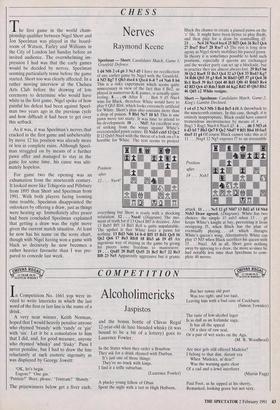CHESS
Nerves
Raymond Keene
The first game in the world cham- pionship qualifier between Nigel Short and Jon Speelman was played in the board- room of Watson, Farley and Williams in the City of London last Sunday before an invited audience. The overwhelming im- pression I had was that the early games would be decided by nerves, Speelman seeming particularly tense before the game started. Short too was clearly affected. In a rather moving interview at the Chelsea Arts Club before the drawing of lots ceremony to determine who would have white in the first game, Nigel spoke of how painful his defeat had been against Speel- man two years ago in the previous cycle and how difficult it had been to get over this setback.
As it was, it was Speelman's nerves that cracked in the first game and unbelievably by move 12 his position was already more or less in complete ruins. Although Speel- man struggled on by means of a further pawn offer and managed to stay in the game for some time, his cause was ulti- mately hopeless.
For game two the opening was an exhumation from the nineteenth century. It looked more like Tchigorin and Pillsbury from 1895 than Short and Speelman from 1991. With both players facing looming time trouble, Speelman disappointed the onlookers by offering a draw, just as things were heating up. Immediately after peace had been concluded Speelman explained that getting a draw was the right move given the current match situation. At least he now has his name on the score chart, though with Nigel having won a game with black so decisively he now becomes a rather heavier favourite than I was pre- pared to concede last week. Speelman — Short: Candidates Match, Game 1; Grunfeld Defence.
1 d4 Nf6 2 c4 g6 3 Nc3 d5 I have no recollection of any earlier game by Nigel with the Grunfeld. 4 Nf3 Bg7 5 Qb3 dxc4 6 Qxc4 0-0 7 e4 Na6 8 b4 This is a risky experiment which seems quite unnecessary in view of the fact that 8 Be2, as played in numerous K-K games, is actually quite testing. 8 . . . c6 After 8 . . . Be6 9 d5 Nxe4 wins for Black, therefore White would have to play 9 Qb5 Rb8, which looks extremely artificial for White. Short's plan also contains more than a drop of poison. 9 Rb1 Nc7 10 h3 This is one pawn move too many. It was time to attend to his development. 10 . . Nb5! An excellent way of striking from the wings against White's overextended pawn centre. 11 NxbS cxb5 12 Qc2 If 12 Oxb5 Nxe4 with the threat of a fork on c3 is horrible for White. The text seems to protect
Position after 12 . . Nxe4!
everything bu Short is ready with a shocking refutation. 12 . . . Nxe4! (Diagram) The mo- ment of truth for if 13 Qxe4 Bf5 is decisive. Also 13 Bxb5 Bf5 14 Bd3 Rc8 is quite unpalatable. The upshot is that White loses a pawn for nothing. 13 Bd3 Nd6 14 0-0 Bf5 15 Rdl Qc8 16 Qe2 Qe6 17 Be3 Rfc8 18 Rb3 a6 19 d5 An ingenious way of staying in the game by giving his pieces some freedom to manoeuvre.
19 QxdS 20 BxfS QxfS 21 Bc5 Rc7 22 Re3 Bf8 23 Ne5 Apparently aggressive but it grants Black the chance to create a passed pawn on the 'c' file. It might have been better to play Bxd6, and then play for a draw by controlling d5. 23 . . . Nc4 24 Nxc4 bxc4 25 Rf3 Qe6 26 Re3 Qc6 27 Bxe7 Bxe7 28 Rxe7 c3 The rest is long slow agony as Nigel slowly mobilises his passed pawn. In theory it is sometimes possible to hold such positions, especially if queens are exchanged and the weaker party can set up a blockade, but in practice they are almost always lost. 29 Re5 b6 30 Qc2 RacS 31 Re3 Qc4 32 a3 Qc6 33 Red3 Kg7 34 Rd6 Qb5 35 g3 Re8 36 R6d3 Qf5 37 g4 Qe4 38 Rcl RecS 39 Re3 Qd4 40 Rdl Qf6 41 Rdd3 Rc4 42 Rf3 Qc6 43 Rde3 Rd8 44 Kg2 Rd2 45 Qb3 Rb2 46 Qdl c2 White resigns.
Short — Speelman: Candidates Match, Game 2; King's Gambit Declined.
1 e4 e5 2 Nc3 Nf6 3 Bc4 Bc5 4 14 A throwback to the nineteenth century. In this case, though, it is entirely inappropriate. Black could have caused tremendous inconvenience by means of 4 . . . Bxgl 5 Rxgl Nxe4 6 Nxe4 d5. 4 . . . d6 5 Nf3 c6 6 d3 b5 7 Bb3 Qe7 8 Qe2 Nbd7 9 Rfl Bb4 10 fxe5 dxe5 11 g4 Of course Black cannot take this as if 11 . . .Nxg4 12 Ng5 exposes f7 to an irresistible
Position after 14 . . Nxb3
attack. 11 . . . Nc5 12 g5 Nfd7 13 Bd2 a5 14 Nh4 Nxb3 Draw agreed. (Diagram). White has two choices: the simple 15 axb3 when 13 . . . g6 keeps White's knight at bay, preventing it from occupying f5, when Black has the plan of eventually playing . . . a4 which disrupts White's queen's wing. Alternatively White can play 15 Nf5 when Black sacrifices his queen with 15 . . . Nxal. All in all, Short gave nothing away by agreeing to a draw, the more so since he had notably less time than Speelman to com- plete 40 moves.


















































 Previous page
Previous page